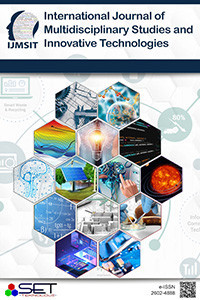Machine Learning for E-triage
Machine Learning for E-triage
Triage, Machine Learning, Emergency Department, Random Forest, Support Vector Machine, Decision Trees, Kth Nearest Neighbor,
___
- M. Oberlin, E. Andr`es, M. Behr, S Kepka, L. Borgne, P., Bilbault, , “Emergency overcrowding and hospital organization: Causes and solutions”, La Revue de Médecine Interne, vol. 41(10),pp. 693-699, 2020.
- Ministry of Health of the Republic of Turkey. “Yataklı Sağlık Tesislerinde Acil Servis Hizmetlerinin Uygulama Usul Ve Esasları Hakkında Tebliğ”. https://www.saglik.gov.tr/TR,11321/yatakli-saglik-tesislerinde-acil-servis-hizmetlerinin-uygulama-usul-ve-esaslari-hakkinda-teblig.html, Access date: 22 April 2022
- H. M. Buschorn, T. D. Strout, J. M. Sholl, M. R. Baumann and G. Junction, “Emergency Medical Services Triage Using the Emergency Severity Index: Is it Reliable and Valid?”, Journal of Emergency Nursing, vol. 39(5), pp. 55-63, 2013.
- M. Christ, F. Grossmann, D. Winter,, R. Bingisser and E. Platz “Modern triage in the emergency department”, Deutsches Ärzteblatt International, vol. 107(50), pp. 892, 2010.
- S. Levin, M. Toerper, E. Hamrock, J. S. Hinson, S. Barnes, A. Dugas, B. Linton, T. Kirscj and G. Kelen “Machine Learning based electronic triage more accurately differentiates patients with respect to clinicaloutcomes compared with the emergency severity index”, 71(5), Annals of Emergency Medicine, pp. 565-574, 2018.
- A. W. Choi, T. Ko K.J. Hong and K. H. Kim,.“Machine learning-based prediction of the Korean triage and acuity scale level in emergency department patients”, Healthcare Informatics Research, vol. 25(4), pp. 305-312, 2019.
- S. Bong, L. H. Kim, H. Kim, C. Kang, S.H. Lee, J. H. Jeong, S. C. Kim, Y. J Park. and D. Lim, “Emergency department triageearly warning score (TWERS) predicts in-hospital mortality in the emergency department”, The American Journal of Emergency Medicine, vol. 38(2) , pp. 203-210,2020.
- J. M. Kwon, Y. Lee, S. Lee, H. Park, J. Park, “Validation of deep learning based triage and acquity score using a large national dataset”, PLoS One,vol. 13(10), 2018.
- M. K. Patil, , S. D. Sawarkar and, M. S. Narwane, “Designing a model to detect diabetes using machine learning”, Int. J. Eng. Res. Technol, 8(11), 333-340,2019.
- L. Cunhe and W. Chenggang,"A new semi-supervised support vector machine learning algorithm based on active learning", 2nd International Conference on Future Computer and Communication, pp. 638-641, 2010.
- V. Vapnik, The Nature of Statistical Learning Theory. New York:Springer-verlag, 2000.
- T. Cover and P. Hart, "Nearest neighbor pattern classification", IEEE transactions on information theory, vol. 13(1),pp. 21-27, 1967
- T. Hastie, R. Tibshirani and J. H. Friedman, The elements of statistical learning: data mining, inference, and prediction, New York Springer, 2009.
- Bounsaythip, C., Rinta-Runsala, E. 2001. “Overview of data mining for customer behavior modeling”, VTT Information Tech. Rep., vol 1, pp.1-53, 2001.
- G. Biau and E. Scornet, “A random forest guided tour” , Test, vol 25(2), pp. 197-227, 2016.
- S. Raschka, Python Machine Learning.UK: Pack Publishing, 2015.
- J. R. Quinlan , C4.5 Programs for Machine Learning, USA, Morgan Kauffman, 1993
- L. Breiman, “Random Forests”, Machine Learning, vol. 45, pp. 5-32,Springer,2001.
- J. Mingers, “An empirical comparison of pruning methods for decision tree induction”, Machine Learning, vol. 4, pp. 227-243, 1989.
- M. Pal, “Random forest classifier for remote sensing classification”, International journal of remote sensing, 26(1), 217-222, 2005.
- ISSN: 2602-4888
- Yayın Aralığı: Yılda 2 Sayı
- Başlangıç: 2017
- Yayıncı: SET Teknoloji
Mehmet İŞCAN, Ali Ihsan TAS, Berkem VURAL, Ali Burak OZDEN, Cüneyt YILMAZ
2-(2- İyodofenil)isoindolin-1,3-dion) Molekülünün Hesaplamalı Kimya Yöntemiyle Yapısal Analizi
Gonca ÖZDEMİR TARI, Güneş DEMİRTAŞ
Efficient Hardware Optimization for CNN
Seda GÜZEL AYDIN, Hasan Şakir BİLGE
FLOOD FORECASTING USING NEURAL NETWORK: APPLYING THE LSTM NETWORK IN THE MOSUL REGION. IRAQ
Abdullahi Abdu IBRAHİM, Ayad Khalaf JIRRI HALBOOSH
Explication of the Remote Education Through Department Statistics: ESOGU-CENG Case Study
Merve CEYHAN, Yusuf KARTAL, Sinem BOZKURT KESER, Savaş OKYAY, Nihat ADAR
American Sign Language Recognition using YOLOv4 Method
Ali AL-SHAHEEN, Mesut ÇEVİK, Alzubair ALQARAGHULI
Sentiment Analysis Of Tweets Using Natural Language Processing
Author Identification with Machine Learning Algorithms
İbrahim YÜLÜCE, Feriştah DALKILIÇ
Makine Öğrenimi ile Uzun Kuyruk Ürünler için İyileştirilmiş Sonraki Öğe Önerisi
Ahmet ZENCİRLİ, Harun ÇETİN, Nedim TUĞ, Engin SEVEN, Tolga ENSARİ
Increasing Water Efficiency by Using Fuzzy Logic Control in Tomatoes Seedling Cultivation
